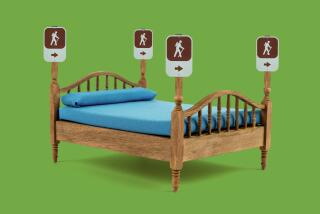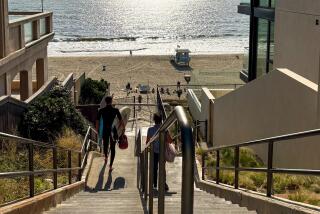To the LIGHTHOUSES
- Share via
ISLAND OF SKYE, Scotland — The woman behind the counter at a local shop warned that I still had a long hike ahead before I reached the lighthouse. “You’ll have to leave your car at the end of the road and walk from there,” she said.
More than half an hour later, having descended a punishingly steep row of steps built into the hillside, I was rewarded with my first glimpse of Neist Point Lighthouse: a bright white tower standing atop a small cluster of buildings on the edge of a sheer cliff, the roaring sea just yards beyond.
It had taken two hours by land and by bridge to drive from the Scottish mainland to this lighthouse on the western edge of the Island of Skye. It was well worth the effort. Around me were sea, sky, rocks and grassland, creating what may well be one of the most dramatic vistas in Britain.
Neist Point is one of an increasing number of old lighthouses that have been converted into vacation accommodations. After visiting Neist Point, which I first learned of in a Scottish tourist brochure, I became intrigued by the notion of lighthouses as lodgings and set off to find a few. I soon learned that there is no guidebook or tourist office to turn to. So I made it my mission last summer to leave my London home and tour the very edges of the rugged British coastline to find them.
*
Neist Point was built in 1909 to guide ships around the Little Minch strait that separates the Island of Skye from the Outer Hebrides islands along Scotland’s northwestern coast. It was staffed by professional keepers until 1987, when it became fully automated.
Since then, as with many of Britain’s other lighthouses, the collection of buildings surrounding (but not including) the tower have been purchased by a private individual. These structures are owned by Roy Stoten, a big, burly Englishman who bought them about four years ago.
As Stoten and I climbed the narrow steps of the tower into the lamp room, where the working lighthouse’s giant beacon is contained, he told me the story of buying the surrounding buildings. In 1993, he was sitting in a cafe in Fort William, Scotland, reading the paper, when he saw an ad for the lighthouse. Almost immediately he hopped into his van and made the three-hour drive west to offer his bid in person. “I was excited about the prospect of living on the very edge of the country,” he said.
A property developer by profession, Stoten has spent most of his time since then renovating the buildings into three cottages: one a bed and breakfast, rented on a per-night basis, the others self-catering cottages with kitchens, rented a week at a time.
All the cottages are comfortably furnished with color TVs, microwave ovens and modern showers, and all have views from the windows that are simply sensational. To protect guests from the intensity of the lighthouse beacon, there are thick, heavy curtains cloaking each window.
Such solitude does have its drawbacks. The nearest shop is four miles away, and the nearest town of any size is 35 miles away. And with such a steep access path, you would never be tempted to go out for a pint in the evening--even if there were a local pub. But I spent an excellent evening walking along the cliffs, with the silhouette of the Outer Hebrides clear against the setting sun.
After leaving Neist Point, I drove back down the west coast and headed for Corsewall Lighthouse, a few miles from Stranraer in southwestern Scotland. In the early 1990s, owner Jim Nielson spent nearly two years transforming the old lighthouse into a small luxury hotel. Nielson masterminded the work, which involved totally gutting the buildings and scouring Scotland for the various artifacts he has displayed within. Model ships in bottles are everywhere, and even the carpeting has a lighthouse motif.
I first encountered Nielson returning from an early morning dip in the blustery sea. He told me he had wanted to own a lighthouse since he was a child and that he spends most of his time trying to think of ways to make the lighthouse more comfortable. Among his ideas are binoculars and telescopes distributed around the building, including one telescope made in the 1820s and kept in the reception area for patrons. The lighthouse also has a nice 12-table restaurant, as well as library of videos and books. There are plenty of healthy walking experiences waiting nearby, with excellent views in every direction.
Although the lighthouse is only a 15-minute drive from Stranraer’s busy ferry terminal (the main ferry port between Scotland and Larne, Northern Ireland), it offers wonderful solitude. I spent several hours sitting on a cliff, watching the ferries pass and the waves splash onto the rocks.
Corsewall’s six guest rooms are in the main building next to the lighthouse tower. (Nielson lives in a converted cottage next door.) Two rooms are on the ground floor; the remainder are on the floor above. All the rooms have been elegantly decorated and equipped with TV, telephone and trousers press. Most have views of the sea.
*
My next stop was at Llandudno Lighthouse, built in 1862 on a huge block of limestone on the north Wales coast. In the late 1980s, Llandudno was turned into an upscale B&B; overlooking a 360-foot-high cliff with a dramatic view of waves and rocks below.
Despite the surrounding barren terrain, the lighthouse is surprisingly accessible. It’s only a couple of miles down a quiet private road from Llandudno town center, and less than a 1 1/2-hour drive from the large industrial towns of Liverpool and Manchester. Such accessibility means that you can enjoy other attractions during the day and relax in peace at the lighthouse at night.
Unlike what is often visualized as a lighthouse, there is no tall tower here; the structure that once housed the beacon is only two stories. There are only three guest rooms, two with double beds and one suite with room for four guests. The ocean view is almost hypnotic from the lamp room, which has been transformed into a small conservatory with comfortable armchairs. On a clear day you can see the Isle of Man and on a clear night, the lights of the Northern Ireland coast.
Despite the modernization, many of the original features remain, such as pine shutters over some of the windows, a 19th century fireplace and a double bed dating from the 1870s.
Breakfast is served on a large table in the Victorian dining room, where guests dine on eggs, toast, sausages, bacon, grilled mushrooms and tomatoes.
Two-hundred miles away, on Wales’ southern coast, near Newport, is another two-story lighthouse: West Usk, owned by Frank and Danielle Sheahan.
In 1987, the Sheahans were living conventional 9-to-5 lives in London when they saw a small ad for a lighthouse for sale for $140,000. It took four years of hard work, one room at a time with much of the work done by the owners, before the place was ready for guests.
The Sheahans now occupy the ground floor of the lighthouse, with six wedge-shaped guest rooms on the floor above reached by the original spiral staircase. There are single and double rooms, including one double with a water bed.
The lighthouse also has a flotation tank, which somehow seems rather out of place. “This is where you can relax in your own private sea,” I was told. But I opted for relaxation induced by the sound of the waves crashing into the rocks below.
I finished my British lighthouse odyssey 150 miles or so away, along England’s south coast, in Portland. Here, close to Thomas Hardy country and about 10 miles from Weymouth, is the Old Higher Lighthouse that was built in 1759, making it one of the oldest lighthouses in the country.
Decommissioned in 1906 and, over the next few decades badly neglected, it wasn’t renovated until the early 1980s. Fran Lockyear and her partner, Les Nickson, spent several years creating this delightfully clean, remote holiday outpost.
On either side of a tower are two cottages that sleep up to four, as well as a newly opened two-bedroom cottage about 10 yards away. There is also an outdoor swimming pool.
The acres of empty countryside also provide opportunities for walking, bird-watching and horseback riding. And there are scuba diving and sailing centers nearby.
Many famous people have visited or stayed at the lighthouse over the years, including Britian’s King George III, H.G. Wells, Thomas Hardy and the Queen’s late uncle, Lord Louis Mountbatten. They were, no doubt, impressed by the panoramic views of the English Channel and the surrounding countryside seen from the large glass windows of the lamp room, 30 feet above the ground.
(BEGIN TEXT OF INFOBOX / INFOGRAPHIC)
GUIDEBOOK: Britain Lighted
Getting there: American and British Airways have connecting service, with one change of planes, from LAX to Glasgow, Scotland. Advance-purchase, round-trip fares start at $970. The Island of Skye is about a 2 1/2-hour drive from Glasgow.
Where to stay: Corsewall Lighthouse Hotel, Corsewall Point, Kirkcolm, Stranraer, Scotland DG9 OQG; telephone 011-44-1776-853-220q, fax 011-44-1776-854-231. Rates: $90 to $150 per person, per night, including dinner and breakfast.
Lighthouse at Llandudno, Marine Drive, Great Ormes Head, Llandudno, Wales LL3 2XD; tel. and fax 011-44-1492-876-819. Rates: $70 to $80 per person, per night.
Neist Point Lighthouse, Glendale, Island of Skye IV55 8WU, Scotland; tel. 011-44-1470-511-200. Rates: $570 to $745 per cottage (up to four people), per week, breakfast not included.
Old Higher Lighthouse, Portland Bill, Dorset DT5 2JT, England; tel. 011-44-1305-822-300. Rates: $80 per night for a double, including breakfast.
West Usk Lighthouse, Lighthouse Road, St. Brides, Newport, Gwent, Wales NP1 9SF; tel. 011-44-1633-810-126. Rates: $30 to $140 per night, per room, including breakfast.
More to Read
Sign up for The Wild
We’ll help you find the best places to hike, bike and run, as well as the perfect silent spots for meditation and yoga.
You may occasionally receive promotional content from the Los Angeles Times.






